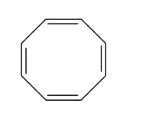Explain why :
Mercury loses its meniscus in contact with ozone.
Step-by-Step Solution:
1. Understanding Meniscus:
- The meniscus is the curve at the surface of a liquid in a container, which is caused by surface tension. In the case of mercury, it typically forms a convex meniscus due to its high surface tension and cohesive forces.
2. Contact with Ozone:
- When mercury (Hg) comes into contact with ozone (O₃), a chemical reaction occurs. Ozone is a strong oxidizing agent, which means it can react with other substances, including metals like mercury.
3. Formation of Mercurous Oxide:
- The reaction between mercury and ozone leads to the formation of mercurous oxide (Hg₂O). This is an important step because the formation of a compound alters the properties of mercury in the container.
- The reaction can be represented as follows:
2Hg+O3→Hg2O+O2
4. Loss of Meniscus:
- As mercurous oxide is formed, it adheres to the glass surface of the container. This adhesion reduces the cohesive forces that mercury has with itself, leading to a loss of the meniscus. Instead of maintaining its shape, mercury tends to stick to the glass.
5. Tailing of Mercury:
- This phenomenon is referred to as the "tailing of mercury." The term describes the behavior of mercury when it loses its meniscus and sticks to the surface of the container due to the formation of mercurous oxide.
Conclusion:
- In summary, mercury loses its meniscus in contact with ozone because ozone oxidizes mercury to form mercurous oxide, which adheres to the glass surface, disrupting the cohesive forces that maintain the meniscus.
- The meniscus is the curve at the surface of a liquid in a container, which is caused by surface tension. In the case of mercury, it typically forms a convex meniscus due to its high surface tension and cohesive forces.
- When mercury (Hg) comes into contact with ozone (O₃), a chemical reaction occurs. Ozone is a strong oxidizing agent, which means it can react with other substances, including metals like mercury.
- The reaction between mercury and ozone leads to the formation of mercurous oxide (Hg₂O). This is an important step because the formation of a compound alters the properties of mercury in the container.
- The reaction can be represented as follows:
2Hg+O3→Hg2O+O2
- As mercurous oxide is formed, it adheres to the glass surface of the container. This adhesion reduces the cohesive forces that mercury has with itself, leading to a loss of the meniscus. Instead of maintaining its shape, mercury tends to stick to the glass.
- This phenomenon is referred to as the "tailing of mercury." The term describes the behavior of mercury when it loses its meniscus and sticks to the surface of the container due to the formation of mercurous oxide.
- In summary, mercury loses its meniscus in contact with ozone because ozone oxidizes mercury to form mercurous oxide, which adheres to the glass surface, disrupting the cohesive forces that maintain the meniscus.
Topper's Solved these Questions
- CHEMISTRY-2018BOOK - ICSECHAPTER - CHEMISTRY-2018EXERCISE - Question (Answer the following question)
5 Videos
- CHEMISTRY-2017BOOK - ICSECHAPTER - CHEMISTRY-2017EXERCISE - Question (Answer the following)
4 Videos
- CHEMISTRY-2019BOOK - ICSECHAPTER - CHEMISTRY-2019EXERCISE - Question (Answer the following questions)
5 Videos
Similar Questions
Mercury loses its meniscus on passing ozone through it. The menicus can be regained:
View SolutionStatement-1 : Mobility of mercury (Hg) decreases and its starts sticking to glass when it brought in contract with ozone.
Statement-2 : Ozone oxidises mercury to Hg2O which dissolves in mercury.
Statement-2 : ozone oxidises mercury to Hg2O which dissolves in mercury.
View SolutionExplain why does the mercury level in a barometer go down when atmospheric pressure decreases?
View SolutionExplain why an iron nail floats on mercury, but it sinks in water.
View SolutionCan you explain why the column of mercury first descends and then rises when a mercury in glass thermometers put in a flame?
View SolutionExplain why the system are not aromatic?

View SolutionExplain why the system are not aromatic?

View SolutionExplain why the system are not aromatic?

View SolutionExplain why ozone is thermodynamically less stable then oxgen ?
View SolutionExplain why high pressure is required in" the manufacture of sulphur trioxide by contact process.
State the law or principle used.
View Solution
